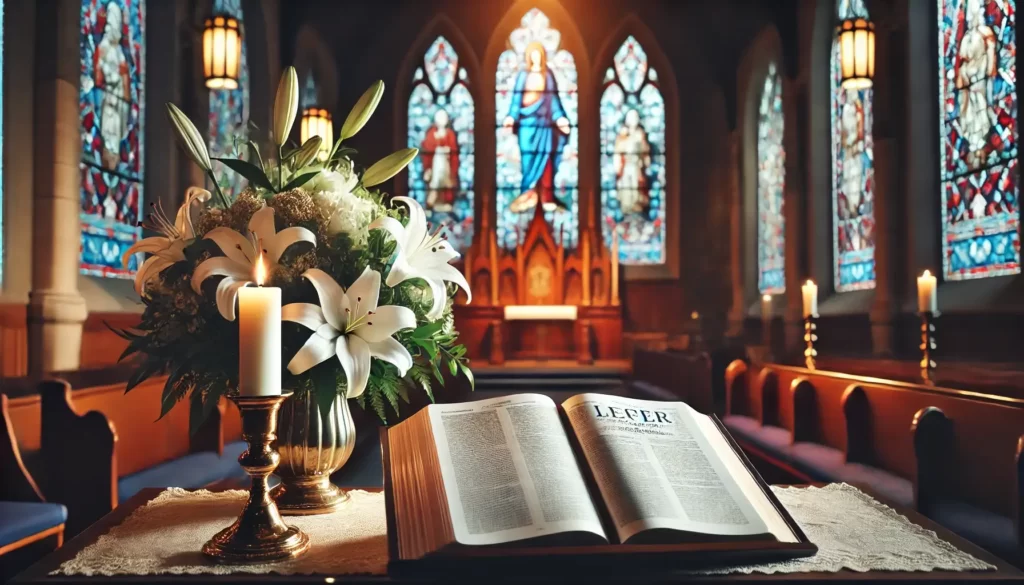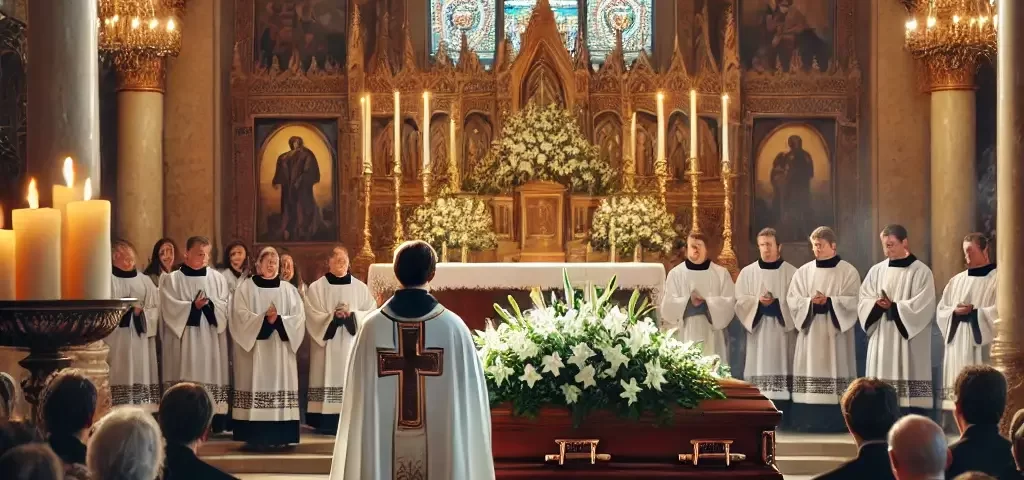Catholic Funeral Rites

Japanese Buddhist Funerals
February 28, 2025
Zoroastrian Funeral Traditions
March 11, 2025Death is not considered the end in Catholicism but the passage to life eternal. It is this belief that, in fact, reflects in each rite of Catholic funerals, where the family shows their grief for the loss and honors their loved one with prayers, scriptures, and sacred traditions. The order of the burial follows more formal liturgy, drawing from centuries-long practices that solidify the doctrine of resurrection and salvation.
The religious traditions of ceremony and ritual, such as scripture readings, hymns, and prayers of hope and remembrance, guide mourners through the service. Catholic funerals are three-part services that, in addition to honoring the deceased, offer spiritual support to the surviving family and friends.
The Three Stages of a Catholic Funeral
Catholic funerals fall into three discrete stages: Vigil, commonly called the Wake; Funeral Mass, sometimes Requiem Mass; then the Rite of Committal, often Burial Service. Each one has a very important purpose of its own so that the departed is prayed for and committed into God’s care.
The Vigil Service (Wake)
The Vigil, held the night before the funeral, enables the family and friends to come together, say their prayers, and share remembrances. This service can be held at the funeral home, church, or family home. Some Vigils are open casket and some are a time of scripture reading and prayer.
Common Bible prayers include:
- The Rosary, which asks for the intercession of the Virgin Mary.
- Psalm 23 (“The Lord is my shepherd”) for comfort and reassurance.
- John 11:25-26, where Jesus speaks about eternal life.
Priests or deacons often lead the service, but family members can also participate by offering reflections or reading passages from the Bible.
The Funeral Mass (Requiem Mass)
The heart of a Catholic funeral would be the Funeral Mass. The funeral Mass is held in church and has a liturgy with prayers, hymns, and scripture readings. It includes the Eucharist, Holy Communion, which makes it true that through such sacrament, union with Christ is attained, and resurrection is very much implied. You can create custom funeral prayer cards at Honor You.
Traditional hymns often heard at a Catholic funeral include:
- “Ave Maria” – A solemn prayer to the Virgin Mary.
- “Be Not Afraid” – A hymn of reassurance and trust in God.
- “On Eagle’s Wings” – A reflection on God’s guidance through grief.
The priest delivers a homily, offering spiritual reflection on the deceased’s life and the hope of eternal salvation. Mourners then receive Holy Communion, strengthening their faith as they say farewell.
The Rite of Committal (Burial Service)
The final rite takes place at the cemetery, which is usually called the Graveside Service. This includes leading the prayers by the priest or deacon while committing the body to the earth below or as the urn of one who was cremated is being placed in his holy place of rest. The final blessing constitutes one of the more commonly known verses :
“Ashes to ashes, dust to dust, in the sure and certain hope of the resurrection.”
While burial has traditionally been preferred, the Catholic Church now permits cremation, provided the ashes are buried in consecrated ground rather than scattered or kept at home.
Key Prayers and Readings in Catholic Funerals
Common Scripture Passages Read During the Service
In Catholic funerals, Scriptures are read for comfort, to guide, and to remind one that God has promised eternal life. This is normally from the Old Testament and the New Testament, emphasizing faith, resurrection, and hope.
Some of the most commonly read passages include:
- Wisdom 3:1-6, 9 – “The souls of the just are in the hand of God, and no torment shall touch them.”
- Romans 8:38-39 – “Neither death nor life… will be able to separate us from the love of God in Christ Jesus our Lord.”
- John 14:1-3 – “Do not let your hearts be troubled… I go and prepare a place for you.”
The Gospel reading is usually chosen by the priest or the family, focusing on Christ’s victory over death.

Importance of Intercessory Prayers and Hymns
The Intercessory prayers, more commonly called Prayers of the Faithful, are said during the Funeral Mass. The petitions pray for God’s mercy not only for the deceased but also for those in sorrow and for the universal Christian family. The following may be used:
- Asking for the deceased’s soul to find rest in God’s presence.
- Praying for family members to find strength and peace.
- Seeking comfort for all who mourn.
Music also plays a significant role. Hymns reflect Catholic beliefs about faith, loss, and eternal life. Some of the most traditional hymns include:
- “Ave Maria” – A solemn prayer to the Virgin Mary.
- “Amazing Grace” – A song about God’s mercy and redemption.
- “On Eagle’s Wings” – A reflection on God’s presence through grief.
The combination of scripture, prayer, and hymns creates a service filled with both sorrow and hope.
Catholic Views on Death and the Afterlife
Teachings on Resurrection and Eternal Life
Catholicism asserts that death seals life, but at the same time, it is a passage to continued life. The origin of this belief in Jesus Christ’s resurrection gives the very foundation for Christian hope. Resurrection in 1 Corinthians 15:52 is presented as change of state:
“For the trumpet will sound, and the dead will be raised imperishable, and we will be changed.”
Catholics believe that the soul continues beyond physical death, with three possible destinations:
- Heaven – Eternal union with God.
- Purgatory – A place of purification before entering heaven.
- Hell – Eternal separation from God for those who reject salvation.
How Catholic Funeral Rites Reinforce Faith in Salvation
Every aspect of the Catholic service of death is framed by belief in resurrection. The assurance of salvation and reunited life in God underlines prayers, scripture, and the Eucharist. At the burial, the Final Commendation is a prayer for God to welcome the dead person into eternal rest.
Catholics pray for the dead with Mass intentions and All Souls’ Day in support that prayer moves these souls out of purgatory into heaven. Such ongoing connection of the living to the dead certainly reinforces the thought that love and faith transcend death.


